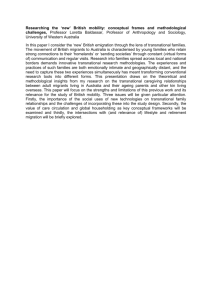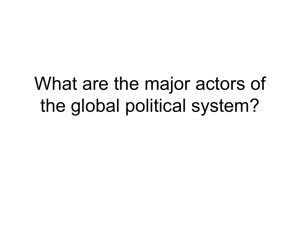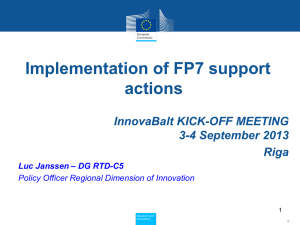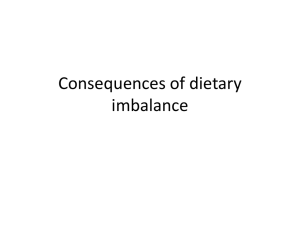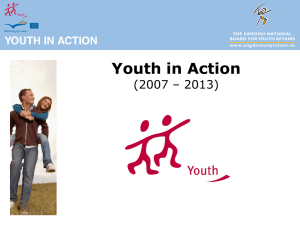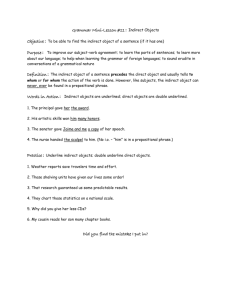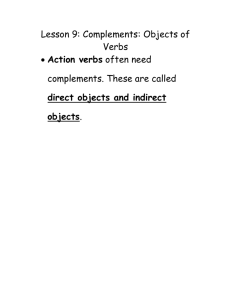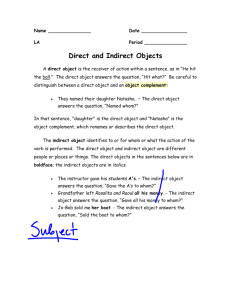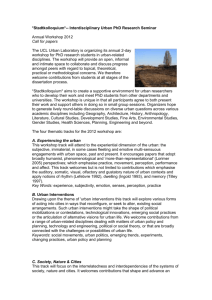Financial issues specific to FP7 Research Infrastructures
advertisement
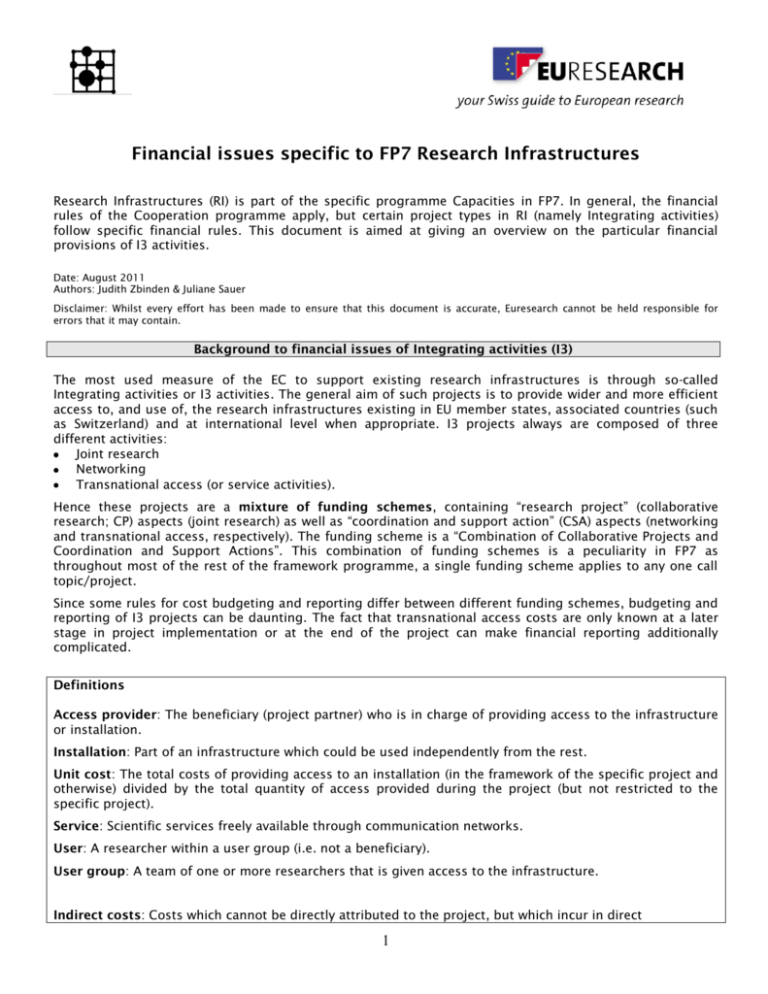
Financial issues specific to FP7 Research Infrastructures Research Infrastructures (RI) is part of the specific programme Capacities in FP7. In general, the financial rules of the Cooperation programme apply, but certain project types in RI (namely Integrating activities) follow specific financial rules. This document is aimed at giving an overview on the particular financial provisions of I3 activities. Date: August 2011 Authors: Judith Zbinden & Juliane Sauer Disclaimer: Whilst every effort has been made to ensure that this document is accurate, Euresearch cannot be held responsible for errors that it may contain. Background to financial issues of Integrating activities (I3) The most used measure of the EC to support existing research infrastructures is through so-called Integrating activities or I3 activities. The general aim of such projects is to provide wider and more efficient access to, and use of, the research infrastructures existing in EU member states, associated countries (such as Switzerland) and at international level when appropriate. I3 projects always are composed of three different activities: Joint research Networking Transnational access (or service activities). Hence these projects are a mixture of funding schemes, containing “research project” (collaborative research; CP) aspects (joint research) as well as “coordination and support action” (CSA) aspects (networking and transnational access, respectively). The funding scheme is a “Combination of Collaborative Projects and Coordination and Support Actions”. This combination of funding schemes is a peculiarity in FP7 as throughout most of the rest of the framework programme, a single funding scheme applies to any one call topic/project. Since some rules for cost budgeting and reporting differ between different funding schemes, budgeting and reporting of I3 projects can be daunting. The fact that transnational access costs are only known at a later stage in project implementation or at the end of the project can make financial reporting additionally complicated. Definitions Access provider: The beneficiary (project partner) who is in charge of providing access to the infrastructure or installation. Installation: Part of an infrastructure which could be used independently from the rest. Unit cost: The total costs of providing access to an installation (in the framework of the specific project and otherwise) divided by the total quantity of access provided during the project (but not restricted to the specific project). Service: Scientific services freely available through communication networks. User: A researcher within a user group (i.e. not a beneficiary). User group: A team of one or more researchers that is given access to the infrastructure. Indirect costs: Costs which cannot be directly attributed to the project, but which incur in direct 1 relationship with the direct costs of the project. Examples: Rent and maintenance of buildings, office and communication equipment. See Guide to Financial issues Art II.15 of EC GA. ftp://ftp.cordis.europa.eu/pub/fp7/docs/financialguide_en.pdf). Financial planning and reporting of I3 projects I3 projects are composed of Collaborative research (CR; Joint research) Coordination activities (CSA; Networking) Support activities (CSA: Transnational access/Service activities) The cost statements (Forms C; due at the end of each reporting period) of almost all project types contain 2 fixed types of activity: “Management” (for costs of management at overall project level) and “Other” (e.g. for costs of training, IPR protection etc.). Additional types of activities are included for different project types. As I3 projects are composed of three additional activity types, the Form C of these projects (Annex VI to the Grant Agreement see ftp://ftp.cordis.europa.eu/pub/fp7/docs/fp7-ga-annex6-cpcsa-v4_en.pdf; Fig. 1) contains 5 different Activity Types: RTD, Coordination, Support, Management and Other. Costs of Networking Costs of Joint Research Costs of overall project management E.g. costs for Costs of overall project Transnational dissemination Access Figure 1: Form C of I3 projects with indications on which project parts to assign to which “Type of Activity” (column). Reimbursement rules Overall project management, networking & joint research Costs for overall project management as well as costs for joint research are reimbursed according to the usual rules as follows: Management and Networking is reimbursed to 100% while Joint research is reimbursed according to the RTD reimbursement rate of the organisation (i.e. 75% for public bodies and SMEs; 50% for large industry). Transnational access An estimate of the unit costs is included in the proposal which becomes Annex I to the Grant Agreement (Description of Work). The unit cost much be a reasonable estimate that can be justified. It is advisable to discuss the unit cost with the financial department of the organisation during proposal preparing. Please also note that the unit of access needs to be clearly defined by each consortium, i.e. it needs to be very clear from the start what a unit of access includes, e.g. if training, technician efforts etc. are included or not. The costs of Transnational access (column “Support” in Form C) contain both direct and indirect costs, whereas the EC maximum contribution to indirect costs is limited to 7% of direct costs. The reimbursement rate is 100%. 2 If transnational access cost provided within the RI project account to more than 20% of total costs for access to the installation (single instrumentation/infrastructure) over the duration of the project, only 20% of the total costs for providing access can be charged to the EC. Note that this rule applies per installation, i.e. for applies for the installation of each beneficiary separately. Travel costs for user groups must be declared under “other direct costs” in the activity type “support”. Travel and subsistence costs related to meetings of the selection panel must likewise be declared under “other direct costs” in the activity type “support”. Calculation of indirect costs Overall project management & joint research For both Management and RTD activities, indirect costs are calculated according to the indirect cost model of the organisation (for more information refer to the Guide to Financial Issues: ftp://ftp.cordis.europa.eu/pub/fp7/docs/financialguide_en.pdf). Networking & transnational access Indirect costs are limited to 7% of direct costs. Note that for transnational access, indirect costs are already included in the unit costs (see below). Unlike in projects which are full CSAs, the management of the CSA parts is exempt from this rule. I.e. indirect costs of management of networking and transnational access can be calculated according to the indirect cost model used by the organisation. Special clause 19 to the grant agreement stipulates this rule (see list of special clauses: ftp://ftp.cordis.europa.eu/pub/fp7/docs//fp7-ga-clauses-v6_en.pdf). The indirect costs of activity type “Coordination” and “Support” may be composed of different rates applied to different parts of these activities. Travel & subsistence costs of selection panel members and user groups Access costs charged to the project (including indirect costs) Figure 2: Form C of I3 projects with indication on where to fill in costs for Transnational access. 3 Reporting transnational access costs in I3 projects Reporting periods are defined in the Grant Agreement. At the end of every reporting period, financial statements (Form C) are due. These forms contain the expenditures during the reporting period as well as the cost claim to the European Commission. Periodic financial reports: Transnational access costs are calculated by multiplying the estimated unit cost (as defined in Annex I to the Grant Agreement) by the number of units of access provided to selected userprojects. It is also possible to declare actual unit costs in any or all reporting periods. Adjustments shall be made when the real unit cost is known (see below) as when declaring estimated unit costs. Final financial report: The real unit cost should be known at least at the end of the project. If it differs from the estimated unit cost, adjustments to previous financial statements should be made. If the real unit cost is higher than estimated unit cost, the difference can only be declared under the condition that (i) the minimum quantity of access as defined in Annex I to the Grant Agreement has been provided and (ii) the EC contribution does not exceed 20% of the costs for providing access over the duration of the project and (iii) within the financial limitations (maximum EC contribution) of the Grant Agreement. Some important points for calculating access costs: Capital investment costs (investments that go beyond normal maintenance) must be excluded from calculations of unit costs. Calculations must include access granted to other users than those not supported by the project. Only up to 20% of the costs of the total access provided (within and outside the project) can be claimed from the EC. Access costs should include direct and indirect costs (7% of direct costs, see part 1). The Excel sheet used for calculating estimated unit costs must be used for calculating real unit costs. This document is provided to the EC as part of the reports. As an example, an outdated version is available from Cordis. Special case: Access to services through communication networks and e-Infrastructure activities In special cases, a “service” is made available instead of “access” in I3 projects. Cost for services provided are the counterpart in e-Infrastructure I3 projects of costs for the provision of transnational access in “normal” (i.e. not e-Infrastructure) I3 projects. Conditions for services made available through communication networks and e-Infrastructure activities are additionally defined in special clause 17 (see list of special clauses: ftp://ftp.cordis.europa.eu/pub/fp7/docs//fp7-ga-clauses-v6_en.pdf) which is included in the core Grant Agreement of concerned projects. Budgeting and declaration of costs differs between services through communication networks and eInfrastructure activities and transnational access provided: While transnational access costs must be declared under activity type “Support” (see Fig. 1 above), services costs should be declared under activity type “Other”. For the calculation of indirect costs this means that these are NOT limited to 7% for Services provided (The organisation’s usual indirect cost model applies).contrary to the limitation of indirect costs to transnational access. 4 Costs of Transnational Access (non e-Infrastructure projects) Indirect costs restricted to 7% of direct costs (except for management Access costs to e-Infrastructures Indirect cost according to usual practices Figure 3: Form C of I3 projects showing where to insert costs for access to e-Infrastructure vs. installation services. Useful documents: Annex III to model Grant Agreement (Specific provisions for transnational access activities): ftp://ftp.cordis.europa.eu/pub/fp7/docs/fp7-ga-annex3-infra-v2_en.pdf Reporting transnational access and service activity costs (Guidance notes): ftp://ftp.cordis.europa.eu/pub/fp7/capacities/docs/reporting-ta-service-activities.pdf List of special clauses (special clauses 17, 18, 19 and 39 applicable to certain Research Infrastructure projects): ftp://ftp.cordis.europa.eu/pub/fp7/docs//fp7-ga-clauses-v6_en.pdf. 5 Example: Details of organization Organisation type: public body Indirect cost model: special transitional flat rate (60%) Personnel costs (direct costs): 8’000 € per person-month (PM) Project setup WP1: WP2: WP3: WP4: Project management Joint research Networking Transnational access Efforts & costs WP1 (Project management) Effort: 0.5 PM Travel costs: 1’000 € 0.5 PM * 8’000 € Travel WP 1 4’000 1’000 3’000 8’000 8’000 60% of direct costs (organisations usual indirect cost model) 100% of total costs (reimbursement rate for Management) 6 WP2 (Joint research) Effort: 3.5 PM Consumables: 20’000 € Travel costs: 4’000 € 3.5 PM * 8’000 € WP 2 Consumables + Travel 28’000 24’000 31’200 83’200 62’400 60% of direct costs (organisations usual indirect cost model 75% of total costs (reimbursement rate for RTD, public bodies) 7 WP3 (Networking) Effort for networking: 1.5 PM Travel costs for networking: 2’000 € 1.5 PM * 8’000 € WP 3 Travel 12’000 2’000 8’400 22’400 14’980 60% of direct costs 100% of direct costs (reimbursement rate for coordination activities) plus 7% of direct costs as indirect costs (maximum reimbursement of indirect costs) 8 WP4 (Transnational access) Effort for transnational access: 4 PM Estimated cost per unit of access: 15’000 € Units access granted in total during reporting period: 20 Units access granted within project: Travel costs user groups: 4’000 € per user group Travel costs of selection panel: 5’000 € Travel for selection panel + 4 user groups 4 PM * 8’000 € WP 4 32’000 21’000 32’800 60’000 145’800 0 116’710 0 60% of direct costs excluding access costs (which already include overhead) 4 units of access 9 100% of total direct costs (reimbursement rate for coordination activities) plus 7% of direct costs (excluding access costs) as indirect costs (maximum reimbursement of indirect costs)
